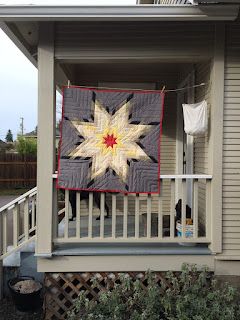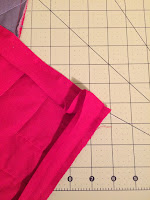Each block of the eo-4 quilt will be designed around a pentagon (green) and a shade piece (medium-toned fabric). The block design is inspired by an activity described in
Fifteen Minutes of Play by Victoria Findlay Wolfe.
The intention is not to have each block be identical - but instead to use:
- block size in each row
- pentagon to represent sagebrush
- shadow piece
as the unifying factors in the quilt. I am not sure someone will really know what they are looking at, but I hope the feel of endless terrain is conveyed to some extent.
The picture below shows the assembly process for the block. The outer square shows the block with the seam allowance, the inner square is the final block. To assemble the blocks, the pentagon will be cut such that it will fit inside the final block dimension - but the pentagons will be randomly shaped (1). A medium scrap for the shadow piece will be added to one edge (2).
After adding the show block, the top edge of fabric joining pieces (1) and (2) will be trimmed, and a piece of light toned fabric will be added (3). Now, the edge between (1) and (3) is trimmed, and piece (4) is added. This process is repeated until all of the edges of the pentagon have been sewn to light-toned scraps. The final addition step will be to trim the edge of (6) and (2) - possibly also (3) - to add a final piece of fabric (7).
At this point, the block can be squared up to match the final block dimensions (outer edge).
For this quilt, a total of 122 blocks are required. The list below shows the list by final block dimension (when sewn into the quilt).
- 6 x 5" blocks
- 7 x 4.5" blocks
- 8 x 4"
- 9 x 3.5"
- 10 x 3"
- 12 x 2.5"
- 30 x 2 " (2 rows of this block size)
- 40 x 1.5" (2 rows of this block size)
The plan is to start with the largest blocks and work my way down. I am a little worried about using up the green fabric before I complete the quilt top. I figure I can piece together the smaller blocks out of scraps if I need to.


















































